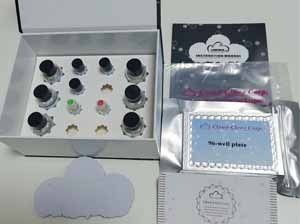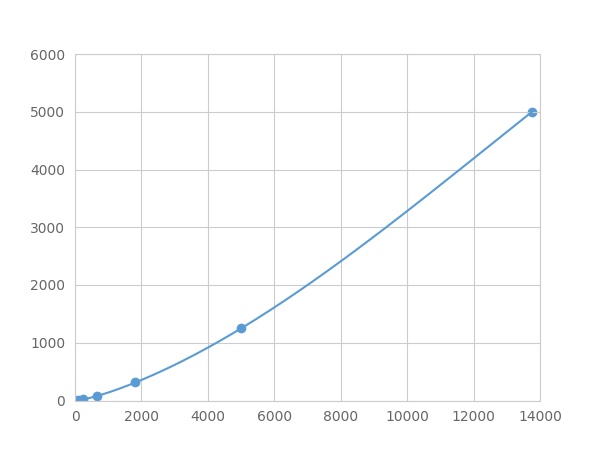Multiplex Assay Kit for Collagen Type IV (COL4) ,etc. by FLIA (Flow Luminescence Immunoassay) 

Type-IV Collagen
(Note: Up to 8-plex in one testing reaction)
- UOM
- FOB US$ 472.00 US$ 490.00 US$ 517.00 US$ 553.00 US$ 590.00 US$ 644.00 US$ 726.00 US$ 907.00
- Quantity
Overview
Properties
- Product No.LMA180Bo
- Organism SpeciesBos taurus; Bovine (Cattle) Same name, Different species.
- ApplicationsFLIA Kit for Antigen Detection.
Research use only - DownloadInstruction Manual
- CategoryTumor immunityHepatology
Sign into your account
Share a new citation as an author
Upload your experimental result
Review

Contact us
Please fill in the blank.
Recovery
Matrices listed below were spiked with certain level of recombinant Collagen Type IV (COL4) ,etc. by FLIA (Flow Luminescence Immunoassay) and the recovery rates were calculated by comparing the measured value to the expected amount of Collagen Type IV (COL4) ,etc. by FLIA (Flow Luminescence Immunoassay) in samples.
| Matrix | Recovery range (%) | Average(%) |
| serum(n=5) | 85-96 | 90 |
| EDTA plasma(n=5) | 79-91 | 79 |
| heparin plasma(n=5) | 92-103 | 99 |
| sodium citrate plasma(n=5) | 88-96 | 93 |
Precision
Intra-assay Precision (Precision within an assay): 3 samples with low, middle and high level Collagen Type IV (COL4) ,etc. by FLIA (Flow Luminescence Immunoassay) were tested 20 times on one plate, respectively.
Inter-assay Precision (Precision between assays): 3 samples with low, middle and high level Collagen Type IV (COL4) ,etc. by FLIA (Flow Luminescence Immunoassay) were tested on 3 different plates, 8 replicates in each plate.
CV(%) = SD/meanX100
Intra-Assay: CV<10%
Inter-Assay: CV<12%
Linearity
The linearity of the kit was assayed by testing samples spiked with appropriate concentration of Collagen Type IV (COL4) ,etc. by FLIA (Flow Luminescence Immunoassay) and their serial dilutions. The results were demonstrated by the percentage of calculated concentration to the expected.
| Sample | 1:2 | 1:4 | 1:8 | 1:16 |
| serum(n=5) | 81-91% | 79-96% | 81-99% | 86-99% |
| EDTA plasma(n=5) | 81-90% | 91-99% | 92-101% | 80-104% |
| heparin plasma(n=5) | 91-98% | 89-97% | 93-101% | 80-99% |
| sodium citrate plasma(n=5) | 78-99% | 82-92% | 86-99% | 88-101% |
Stability
The stability of kit is determined by the loss rate of activity. The loss rate of this kit is less than 5% within the expiration date under appropriate storage condition.
To minimize extra influence on the performance, operation procedures and lab conditions, especially room temperature, air humidity, incubator temperature should be strictly controlled. It is also strongly suggested that the whole assay is performed by the same operator from the beginning to the end.
Reagents and materials provided
| Reagents | Quantity | Reagents | Quantity |
| 96-well plate | 1 | Plate sealer for 96 wells | 4 |
| Pre-Mixed Standard | 2 | Standard Diluent | 1×20mL |
| Pre-Mixed Magnetic beads (22#:COL4) | 1 | Analysis buffer | 1×20mL |
| Pre-Mixed Detection Reagent A | 1×120μL | Assay Diluent A | 1×12mL |
| Detection Reagent B (PE-SA) | 1×120μL | Assay Diluent B | 1×12mL |
| Sheath Fluid | 1×10mL | Wash Buffer (30 × concentrate) | 1×20mL |
| Instruction manual | 1 |
Assay procedure summary
1. Preparation of standards, reagents and samples before the experiment;
2. Add 100μL standard or sample to each well,
add 10μL magnetic beads, and incubate 90min at 37°C on shaker;
3. Remove liquid on magnetic frame, add 100μL prepared Detection Reagent A. Incubate 60min at 37°C on shaker;
4. Wash plate on magnetic frame for three times;
5. Add 100μL prepared Detection Reagent B, and incubate 30 min at 37°C on shaker;
6. Wash plate on magnetic frame for three times;
7. Add 100μL sheath solution, swirl for 2 minutes, read on the machine.

Test principle
Analyte-specific antibodies are pre-coated onto color-coded microparticles. Microparticles, standards, and samples are pipetted into wells and the immobilized antibodies bind the analytes of interest. After washing away any unbound substances, a biotinylated antibody cocktail specific to the analytes of interest is added to each well. Following a wash to remove any unbound biotinylated antibody, Streptavidin-Phycoerythrin conjugate (Streptavidin-PE), which binds to the biotinylated detection antibodies, is added to each well. A final wash removes unbound Streptavidin-PE and the microparticles are resuspended in buffer and read using the Luminex or Bio-Plex analyzer.The MFI developed is proportional to the concentration of analytes of interest in the sample.
Giveaways
Increment services
Citations
- Angiotensin-Converting Enzyme 2 Overexpression Remarkably Ameliorated Glomerular Injury in a Rat Model of Diabetic Nephropathy: A Comparison with ACE InhibitionMolMed: 10_11_liu
- Advanced oxidation protein products induce mesangial cell perturbation through PKC-dependent activation of NADPH oxidasePubMed: 19019916
- Serum Levels of Matrix Metalloproteinase-2 as a Marker of Intimal HyperplasiaScienceDirect: S0022480409001942
- Protein synthesis and secretion in human mesenchymal cells derived from bone marrow, adipose tissue and Wharton's jellyPubmed: 24739658
- Identification of compounds from the water soluble extract of Cinnamomum cassia barks and their inhibitory effects against high-glucose-induced mesangial cells.Pubmed: 24013407
- Bioactive compounds from Cornus officinalis fruits and their effects on diabetic nephropathyScienceDirect: S0378874114002414
- Protective Effects of Norursodeoxycholic Acid Versus Ursodeoxycholic Acid on Thioacetamide-induced Rat Liver FibrosisScienceDirect: S0973688314000073
- Attenuation of renal ischemia/reperfusion injury by a?aí extract preconditioning in a rat modelPubmed:25476829
- Mesenchymal stromal cell proliferation, gene expression and protein production in human platelet-rich plasma-supplemented mediaPubmed:Pmc4130592
- Trophoblasts and Decidual Stromal Cells Regulate Decidual NK Cell Functions Via Interaction between Collagen and LAIR-1Pubmed:24548186
- Camel milk attenuates the biochemical and morphological features of diabetic nephropathy: Inhibition of Smad1 and collagen type IV synthesisPubMed: 25617480
- The Relationship of the Degree of Hepatic Fibrosis with Hyaluronic Acid, Type 4 Collagen, and Procollagen Type 3 N-Terminal Peptide Levels in Patients with Chronic Viral HepatitisOpenview: 8A0B8C97D72C61741371F33508760B75
- Pathological characterization and morphometric analysis of hepatic lesions in SHRSP5/Dmcr, an experimental non-alcoholic steatohepatitis model, induced by high-fat and high-cholesterol dietdoi:10.1111
- Clinical significance of serum laminin and typeâIV collagen levels in cutaneous melanoma patientsPubmed:27330797
- Key Matrix Proteins Within the Pancreatic Islet Basement Membrane Are Differentially Digested During Human Islet Isolation.pubmed:27456745
- Human decidua mesenchymal stem cells regulate decidual natural killer cell function via interactions between collagen and leukocyte‑associated immunoglobulin‑like receptor 110.3892:mmr.2017.6921
- Phase I and biomarker study of plerixafor and bevacizumab in recurrent high-grade gliomaPubmed:29941486
- Adenovirus‑mediated knockdown of activin A receptor type 2A attenuates immune‑induced hepatic fibrosis in mice and inhibits interleukin‑17‑induced …Pubmed:29620144
- Corn silk (Zea mays L.), a source of natural antioxidants with α-amylase, α-glucosidase, advanced glycation and diabetic nephropathy inhibitory activitiesPubmed: 30530231
- High amplitude stretching of ATII cells and fibroblasts results in profibrotic effectsPubmed: 31290711
- Growth hormone induces Notch1 signaling in podocytes and contributes to proteinuria in diabetic nephropathyPubmed: 31511328
- Pantoea agglomerans chronic exposure induces epithelial-mesenchymal transition in human lung epithelial cells and mice lungsPubmed: 32146192
- Beneficial impact of cathelicidin on hypersensitivity pneumonitis treatment¡ªIn vivo studies33999928
- Advanced glycation end-products associate with podocytopathy in type II diabetic patients
- Increase in Serum MMP-9 and TIMP-1 Concentrations during Alcohol Intoxication in Adolescents—A Preliminary StudyPubmed:35625637







